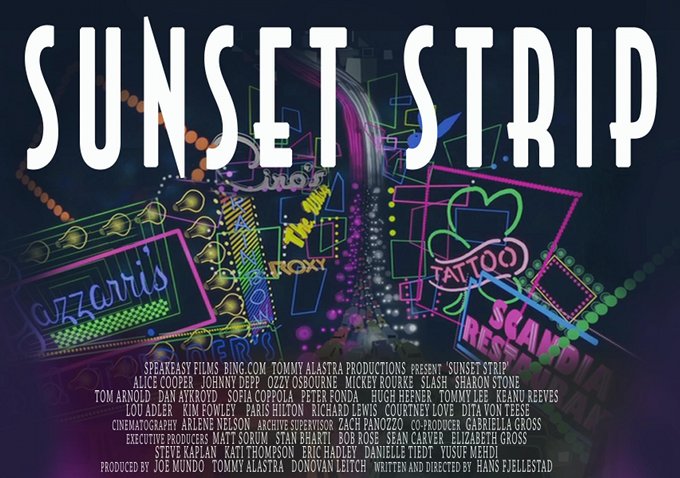 For most, the phrase “Sunset Strip” conjures up images of neon lights, sun-kissed exposed skin and long, druggy, rock-and-roll fueled nights. This is the conceit promised by the new documentary of the same name by Hans Fjellestad, and it (mostly) delivers, offering up a definitive history of the famed street, that is hindered only by a confusion of purpose and a loose structure.
For most, the phrase “Sunset Strip” conjures up images of neon lights, sun-kissed exposed skin and long, druggy, rock-and-roll fueled nights. This is the conceit promised by the new documentary of the same name by Hans Fjellestad, and it (mostly) delivers, offering up a definitive history of the famed street, that is hindered only by a confusion of purpose and a loose structure.
"Sunset Strip” opens with a recitation of a poem by iconic Strip tattoo artist Mark Mahoney. In his cigarettes and whisky whisper, he paints a seedy, beautiful, Bukowski-esque picture that is our first introduction to the fable of the Sunset Strip that is about to be told. Fjellestad eschews the traditional talking heads interview format by arranging conversations of a sort, combining characters like Mickey Rourke and Mahoney to chat about their memories, while sitting inside one of the famous locations the film sets out to historicize. This approach is a rather interesting take on the traditional doc form, allowing a cozy intimacy to arise in the storytelling, rather than the clinical feels of the typical talking-into-the-camera setting, but Fjellestad gives up some of the control in shaping the conversation, which can be both a good thing (allowing for organic moments to reveal themselves), and a bad thing (as some might veer off track).
The film tells the story of the Sunset Strip through its landmarks and locations, so ostensibly it’s structured both chronologically and spatially. Fjellestad ends up spending most of the time on the '50-'70s era (cruelly denying us more of the '80s hair metal years), glorifying the glamorous heyday of classical Hollywood at Ciro’s and the Trocadero, and then moving on to the days of The Doors at the Whisky-A-Go-Go and The Roxy. Many a tall tale is told, the stories that have become legends about movie stars, gangster Mickey Cohen, groupies, Led Zeppelin, wild parties, and the influential music that found its footing on the Sunset Strip. The film hops from the Chateau Marmont, to the Hyatt House, to the Rainbow Room, including interviews with everyone from Rodney Bingenheimer to Johnny Depp to socialite Nikki Haskell.
This process all works until about an hour or so in, when it becomes clear that the through-line of the film just isn’t strong enough to reel it on home. As we approach present day, “Sunset Strip” doesn’t know if it wants to be a eulogy or a tribute. While older stars mourn days gone by, young upstarts like Nic and Cisco Adler (heirs to The Roxy) insist they are injecting new life into the legendary spots where ghosts roam.
As this confusion sets in, the structure of the film loses sight of itself. A random set piece with Paris Hilton cruising the Strip in a cop car feels weird and out of place, and Hilton’s pontification about how things have changed on the Strip is laughable (her contemporary Kelly Osbourne’s thoughts are much more intelligent and compelling, surprise surprise). Maybe if it had been introduced as a structuring device earlier in the film, it would have made more sense, but cropping up three-quarters of the way through the film it is just confounding. A beautiful animation of the history of the Strip plays over and after the end credits, but you wish it was shorter or placed somewhere else (or throughout the film!) so that the audience might enjoy it fully. The lack of a clear story thrust and no structural integrity within the doc causes it to flail and never really get back on track.
As a history of the famed place, it’s truly educational and worth the effort, but you might not leave feeling emotionally touched anymore than you might already feel about the Strip. In fact, you might feel a little less inclined to feel that way, as the interviews become repetitive and redundant. It’s wonderful to have all these stories and images in one place, but it might not be the ultimate tribute to the locale we were looking for [B-]

